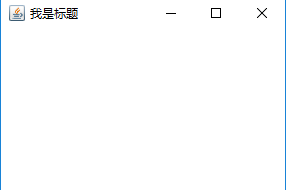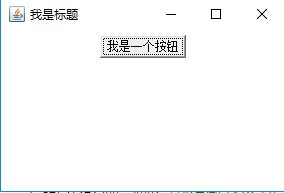Java的GUI學習三(frame)
阿新 • • 發佈:2018-11-13
Java的中文API網址:https://blog.fondme.cn/apidoc/jdk-1.8-google/
學習來自:https://www.cnblogs.com/xingyunblog/p/3841150.html
畢向東的第22天 感覺不錯
GUI初學:
import java.awt.Frame; public class GUI { public static void main(String[] args) { Frame frame = new Frame(); //構建一個最初不可見的Frame例項 frame.setTitle("我是標題"); frame.setLocation(50, 150); //設定視窗位於螢幕左邊的50,上邊下面的150 frame.setSize(300, 200); //設定視窗的高為300寬為200 frame.setVisible(true); //設定窗體可見 } }
結果如圖: 需要注意的是視窗無法直接關閉 需要通過工作管理員或者是通過 console那邊紅色的那個結束本次執行

import java.awt.Frame; import java.awt.Button; public class GUI { public static void main(String[] args) { Frame frame = new Frame(); //構建一個最初不可見的Frame例項 frame.setTitle("我是標題"); frame.setLocation(50, 150); //設定視窗位於螢幕左邊的50,上邊下面的150 frame.setSize(300, 200); //設定視窗的高為300寬為200 frame.setVisible(true); //設定窗體可見 Button b = new Button("我是一個按鈕"); //在視窗中新增一個按鈕; frame.add(b); //將按鈕新增到視窗內; } }
新增一個button 帶有文字標籤的button

設定佈局格式 這邊可以參考這個哦講的挺好的 http://www.cnblogs.com/xingyunblog/p/3841031.html
import java.awt.Frame;
import java.awt.Button;
import java.awt.FlowLayout;
public class GUI {
public static void main(String[] args) {
Frame frame = new Frame(); //構建一個最初不可見的Frame例項
frame.setTitle("我是標題");
frame.setLocation(50, 150); //設定視窗位於螢幕左邊的50,上邊下面的150
frame.setSize(300, 200); //設定視窗的高為300寬為200
frame.setVisible(true); //設定窗體可見
frame.setLayout(new FlowLayout()); //設定窗體佈局為流式佈局
Button b = new Button("我是一個按鈕");
frame.add(b);
}
}

import java.awt.Frame;
import java.awt.GridBagLayout;
import java.awt.Button;
public class GUI {
public static void main(String[] args) {
Frame frame = new Frame(); //構建一個最初不可見的Frame例項
frame.setTitle("我是標題");
frame.setLocation(50, 150); //設定視窗位於螢幕左邊的50,上邊下面的150
frame.setSize(300, 200); //設定視窗的高為300寬為200
frame.setVisible(true); //設定窗體可見
frame.setLayout(new GridBagLayout()); //設定座標式佈局
Button b = new Button("我是一個按鈕");
frame.add(b);
}
}

